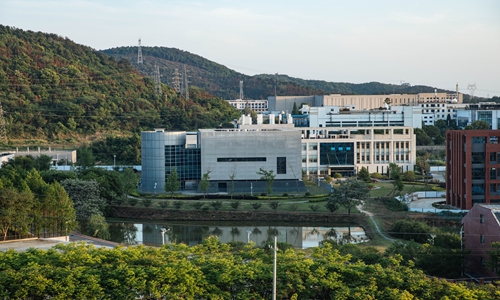What has the Wuhan virus lab done since December?
Source:Global Times Published: 2020/5/10 21:22:55

Wuhan Institute of Virology. Photo: Li Hao/GT
Amid rumors circulating on the internet that the novel coronavirus leaked from the Wuhan Institute of Virology or that it was man-made, lab researchers outlined what the lab has done since December and its work on the frontline of epidemic prevention and control.
In an interview with Beijing-based Technology Daily, Guan Wuxiang, a deputy director of the institute, said the lab started research into COVID-19 on December 30 when it received samples of a pneumonia of an unknown cause from the Wuhan Jinyintan Hospital.
Guan said the institute organized a team to carry out pathogen detection and identification overnight and reported the results to "relevant departments."
The deputy director said that since the outbreak, the lab has carried out virus separation identification, pathogen detection, anti-viral drugs and vaccine research.
The Wuhan lab also evaluated the efficiency of antibodies recovered from patients' plasma, established an animal model and researched the pathogenic mechanism.
The lab obtained the whole genome sequence of the virus and identified it as a novel coronavirus from isolated strains. The virus sequence was submitted to the World Health Organization on January 11.
The institute developed nucleic acid tests and serological detection technologies and products and produced COVID-19 nucleic acid detection kits in cooperation with a Shenzhen medical company.
The kits received emergency approval from the State Food and Drug administration.
In cooperation with a Zhuhai-based company, the lab developed novel coronavirus serological test kits approved on March 14 and obtained the medical device registration certificate.
More than 6,500 pharyngeal swab samples from suspected COVID-19 patients have been tested since January 26.
The lab also worked with researchers from the Academy of Military Sciences PLA China to screen and evaluate COVID-19 drugs and discovered that resochin and favipiravir can effectively contain the novel coronavirus at the vitro cell level.
A COVID-19 vaccine developed with the China National Biotec Group (CNBG) entered clinical trials on April 12.
They also worked with CNBG and evaluated a product created from recovered COVID-19 patients' plasma.
They finished establishing rhesus monkey models for studies on the mechanism and transmission of COVID-19.
Guan said the research team at the lab has studied coronaviruses for more than 10 years.
Their knowledge and methods, such as a SARS general nucleic acid test and antibody detection, were applicable to the coronavirus family and played an important role in early identification of the pathogen.
After the SARS outbreak in 2002, China improved its infectious disease monitoring system and with support of major infectious diseases, the epidemic prevention and control capacity was further enhanced.
The existing system mainly focuses on monitoring and early warning of infectious diseases. It was hard to forecast actively, Guan said, noting that carrying out long-term surveillance and background investigation of the virus carried by wild animals was important in monitoring possible infectious diseases.
The deputy director said "about 12 teams consisting of 120 people" were involved in pathogenic detection, virus monitoring and drug screening work at the lab.
The researchers work at the lab 10 to 12 hours daily including 5 to 6 hours without drinking or eating.
Global Times
Posted in: SOCIETY